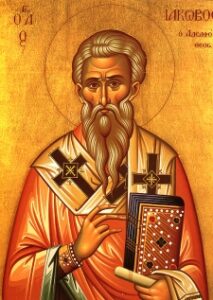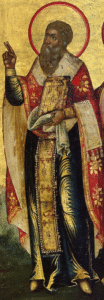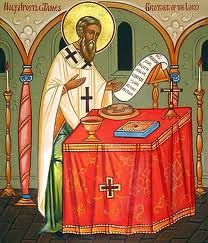St. James – The Just, The Calloused, Brother of our Lord I June 19

The New Testament tells nothing but his name and even the legend and tradition is silent about him, yet a towering and an important spiritual figure of the NT . St. James is not among the first twelve apostles. Truly little is known of them and there is much speculation about his identity. Thirty-eight times the name James is mentioned in the N. T. and there are six possible identities.
- James, the son of Zebedee, Apostle, brother of John, Apostle called ‘James the Greater’
- James, the son of Alphaeus, Apostle.
- James, the brother (cousin) of our Lord (Matt. 13: 55; Mk. 6: 3; Gal. 1: 19).
- James, the son of Mary, brother of Joses (Mk. 15: 40; Matt. 27: 56; Jn. 19: 25)
- James, the brother of Jude (Jude 1: 1)
- James, the father of Judas (Acts 1: 13); not Iscariot
As one can see the variation in the identities. However, scholars are convinced that there are only two or at most three separate identities.
James (1) is out of question as he is identified separately, and known as James, the Greater, was dead by the time of many events recorded here took place (Acts 12: 2). James, the son of Alphaeus, was an Apostle, so his identity is different and was known as the Lesser. He is referred to as James the Less or James the younger Gk. Micros (Mk. 15: 40). So, So, James 1, 2 & 6 are identified differently.
Now if we study the family of Mary, the mother of our Lord, Anna was married to Joachim in Nazareth, parents of Virgin Mary. After Mary was offered to the temple for God’s service another daughter was born to Joachim and Anna and they named her too Mary. This Blessed Virgin Mary’s sister Mary, was married to Clopas or Cleophas, generally translated as Maria Cleophae (Jn. 19: 25), as married women are distinguished by the addition of their husband’s name. So, James, Joses (Joseph), Simon and Judas are brothers (Matt. 13: 55; Mk. 6: 3, Matt. 27: 56; Mk. 15: 40). Alphaeus (Aramaic) and Clopas, Cleopas (Greek)/ are the same name of the Aramaic Halpai. It was not uncommon for a man to have two names (Simon-Petrus; Saulus-Paulus). So Alphaeus and Clopas being the same identity, James 3, 4 and 5, is all the same person, also called James Adelphos.
Among the cousin brothers of Jesus – James, Joses, Simon and Judas are mentioned (Matt. 13: 55, Mark 6: 3). His cousins at first did not believe in the Lord (Jn. 7: 5), After the Ascension of Christ, all His cousins believed in the Lord. The cousins of the Lord had prominence in the early Church. All, including Peter obeyed James (Gal. 2:12). These are different verses denoting the prominence of the Lord’s brothers. (Acts 1: 12, 14; 12: 17; 21: 18, 1 Cor. 9: 5, Gal. 1: 18, 19). Paul called him, Pillar of the Church (Gal. 2: 9), along with Peter and John.
James is only mentioned in the lists and individually we hear nothing about him, until after Resurrection. St. Paul mentions that the Lord appeared to James before Ascension (1 Cor. 15: 5-7). Then again, we lose sight of James till St. Paul after three years after his conversion (A. D. 37), went up to Jerusalem. Of the twelve Apostles he saw only Peter and James, the brother of the Lord (Gal. 1: 19). When in the year A. D. 44, Peter escaped from prison, he desired that news of his release be carried to James, who had already marked preeminence in the Church of Jerusalem (Acts 12: 17).
In the council of Jerusalem (A. D. 50), James gives the sentence and decision after Peter spoke, and offer advice regarding the treatment of Gentiles, who want to follow Christ (Acts 15: 13), settling a major dispute between the Jewish Christians and the Gentile converts.
James was without doubt the Bishop of Jerusalem (Acts 12: 17; 15: 13; 21: 18; Gal. 1: 19; 2: 19-12), and he governed Jerusalem for thirty years, before his martyrdom. He is the author of the first of the General or Catholic (Universal) Epistle, It only says “James, a servant of God and of the Lord Jesus Christ”(James 1: 1). He is said to have authored the book Protoevangelium of St James (or Infancy Gospel of James).
He was well-respected leader in the young Christian Church, his piety and strict adherence to the Law of God, fetched respect him of both Christians and Jews and he eventually became known as James the Just or James the Righteous, just because of his outstanding virtue, was the first, as the record tells us, to be elected to the episcopal throne of the Jerusalem Church.
He wrote as pastor instructing his flock, he was certainly well grounded in the teachings of the Gospel. It was addressed to the twelve tribes of Israel, but its message equally applies to the 20the Century. Tradition respecting James the Less are to be found in many extra-canonical documents. The epistle contains practical advice and instructions helpful to Christian life. It was a cannon meant for Christian Communities, in different places. The author gives fine examples that, encourage true Christian Outlook and Character. These examples contain practical wisdom. He deals with different subjects in a Christian Perspective. Thus, Epistle of James reveals a grave, meek and calm mind, nourished with the scriptures of the Old Testament, given to prayer, devoted to the poor, resigned in persecution, the type of a just and apostolic man. The Epistle of James was written between 40 and 60 AD.

He was a man of prayer. He was holy from his mother’s womb. He drank no wine, ate no meat, never shaved or bathed and knelt that often in prayer that his knees, were calloused like the soles of his feet“. He was the great lover of prayers of night vigils. Because of this so-called holiness he was the first of the apostles to celebrate mass after Jesus’ ascension. There is a legend that states that on the day Jesus’ death he vowed not to eat, until he saw Jesus and on the day of the resurrection Jesus appeared to him first (I Corinthians 15: 3-8) and asked the disciples to prepare food gave some to James saying, “Rise the Son of Man has risen”. We owe to this saintly man ‘The First Liturgy of the Holy Qurbana our Church’ (Thaksa). He was also the first to celebrate the Holy Qurbana at the Sehiyon Mansion after Christ.

He was a witness of the true words and miracles of our Lord and Savior Jesus Christ and a witness of His Passion, Resurrection and Ascension. After the descent of the Holy Spirit at Pentecost, It is believed it fell to the lot of the Apostle James to preach Christ’s Gospel in Eleutheropolis and the surrounding area, and then in Egypt, where he suffered for his Savior. With great power both in word and act, St. James spread abroad the saving news of the incarnate Word of God, rooting out idol worship, driving demons out of men, healing all manner of sickness and disease in the name of the Lord Jesus Christ. His labours and his zeal were crowned with great success. Many pagans came to belief in Christ the Lord, churches were founded and set in order and priests and bishops were made. He suffered in Egypt in the town of Ostracina, being crucified by the pagans. Thus, this great and wonderful Apostle of Christ went to the heavenly Kingdom, to reign forever with the King of glory. We are therefore Christ’s ambassadors, as though God were making his appeal through us; we implore you on Christ’s behalf: Be reconciled to God’. He is remembered in the 5th ‘Thubden’ as ‘the venerable St. James’, ‘the first High Priest of Jerusalem, Saint, Apostle and Martyr’. His memory is commemorated on June 19.
0 Comments